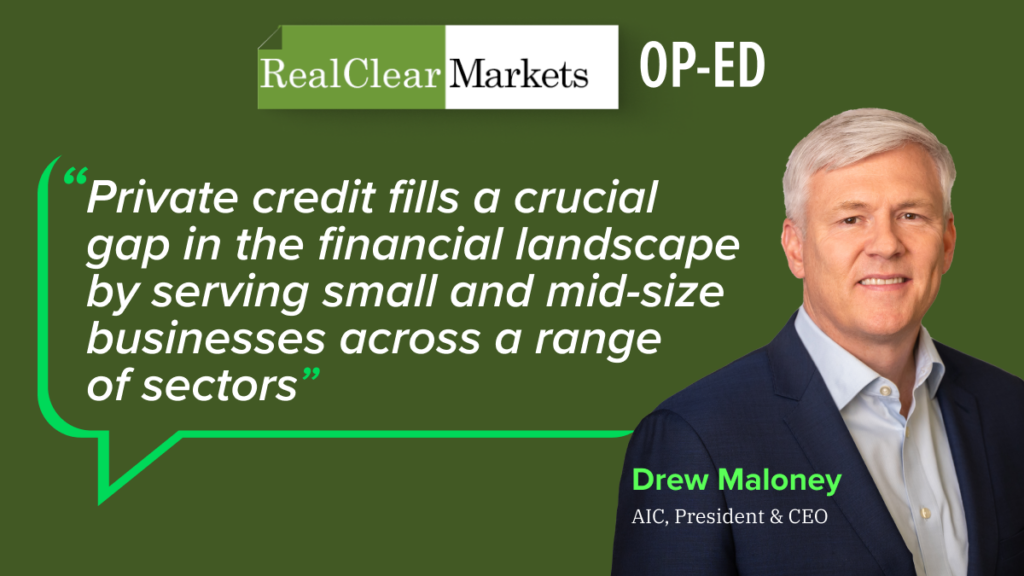Maloney Op-ed in RealClearMarkets Explores Growth and Benefits of Private Credit

This morning, RealClearMarkets published the following op-ed by AIC President & CEO Drew Maloney discussing the growth of the private credit market and its positive impact on small business owners and communities across the country.
Maloney shares how the market has grown from $400 billion to $1 trillion in assets over the past decade while supporting over 3,600 American businesses. He highlights private credit’s appeal to businesses and investors due to its flexibility, high returns, and low volatility, and urges lawmakers to recognize the potential harm of over-regulating the market, especially for small businesses.
Read the full op-ed below:
The Growing Danger of Private Credit Overregulation
By Drew Maloney
From Wall Street to Main Street, everyone in finance is talking about private credit.
This non-bank lending sector has grown from $400 billion to $1 trillion in assets in just a decade, injecting nearly $500 billion into over 3,600 American businesses. Headlines this summer have remarked that the industry is a “juggernaut, “burgeoning,” and in its “golden age.”
Although it’s in the spotlight right now, private credit is not a newcomer to the financial world. Since the late 1970s, small and medium-sized businesses have tapped into this alternative funding source for support, often when they did not qualify for loans from traditional banks or needed capital beyond what banks were able to provide.
So, what is behind this recent growth?
Private credit’s appeal for businesses stems from its flexibility. Loan structures are tailor-made for individual businesses, which is especially critical during periods of economic downturn. When a company runs into trouble and has issues repaying its debt, a private credit firm will work with the company to come to a solution that keeps the company intact, while also providing a return to its investors. Top reasons businesses choose private credit loans are certainty and speed (91%), more flexible covenants (77%), and stable relationships with lenders who hold loans until maturity (65%).
Importantly, private credit fills a crucial gap in the financial landscape by serving small and mid-size businesses across a range of sectors – from manufacturing to the music industry – in all 50 states.
Investors are also drawn to this sector. Since the 2008 financial crisis, direct lending, the most common form of private credit, has consistently outperformed both leveraged loans and high-yield bonds, offering higher returns and lower volatility. Private credit loans also experienced low default rates last quarter, with an overall default rate of only 1.84%.
Major banks have recognized the potential of private credit, partnering with private credit firms to diversify their revenue and offer clients tailored financing solutions. Their vast networks and resources help connect borrowers with lenders, expanding the reach of private credit.
The impact is undeniable: in 2022 alone, EY estimates that private credit supported an estimated 1.6 million jobs, contributing $137 billion in wages and benefits and generating $224 billion for the GDP.
But as the sector grows, so do calls for increased regulation. It’s crucial to recognize the unique nature of this sector and the potential harm of over-regulation, especially for small businesses. Some mistakenly advocate for imposing bank-like regulations on private lenders, overlooking fundamental differences. Private credit doesn’t rely on customer deposits, and its long-term investment structure eliminates the “run risk” associated with banks. The Federal Reserve has recognized this stability, and has previously highlighted the sector’s limited vulnerabilities.
Earlier this summer, Federal Reserve Governor Lisa Cook discussed the impact of increased private credit lending on the resilience of the financial system. She addressed a frequently asked question from policymakers: does the growing private credit market involve a level of risk-taking that could trigger a broader financial crisis? Her answer was clear: the likelihood is low. Researchers from the Fed’s Board of Governors also found that private equity-backed loans have lower credit risk relative to comparable non-private equity-backed loans.
Currently, private credit firms are appropriately regulated by the SEC, ensuring proper registration, on-site SEC examination, comprehensive compliance, and reporting of assets and business information. This existing framework provides a balance between oversight and the flexibility needed for continued growth.
Private credit growth is not just a financial trend; it reflects a broader shift in the way banks and private credit lenders can support small businesses, provide access to capital to grow stronger, invest in their employees, and enter new markets.
Instead of putting up barriers, policymakers should support efforts across the public and private sectors to expand access to funding sources, benefiting small business owners and communities across the country.
###
Drew Maloney is President and Chief Executive Officer (CEO) of the American Investment Council (AIC), the leading advocacy and resource organization established to develop and provide information about the private investment industry and its contributions to the long-term growth of the U.S. economy and the retirement security of American workers.


